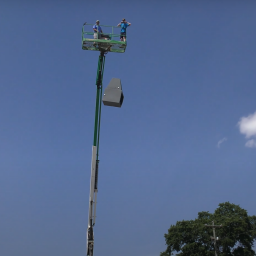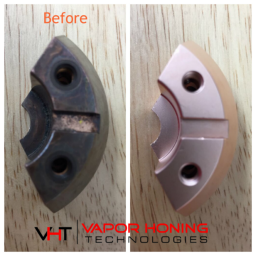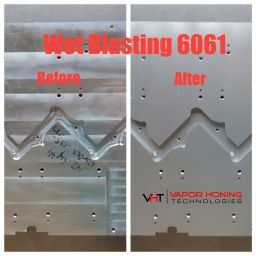Aqua Blasting- What it is and the benefits
In this article we will cover aqua blasting and it’s many benefits and how it compares to sandblasting. Do you own a business where cleaning and finishing surfaces is a common activity? If so, you may already own a sandblaster. But operating these devices comes with dangerous side effects, including silicosis, as well as big messes and lots of noise. Not to mention the explosive dust that’s created with these machines as well.
What’s more, abrasive blasting can do a number on more delicate surfaces and soft metals such as aluminum. Whether you’re an engine builder or a mechanical engineer, it’s time to get on board with using an aqua blasting machine.
Also known as vapor blasting, vapor honing, liquid honing, and wet blasting, this cleaning technology will revolutionize how you prepare and revitalize parts and components.
But what is vapor honing, and how does it work? Here’s what you need to know about removing dirt, grime, paint, corrosion, and more from metal surfaces by utilizing aqua blasting.
What Is Aqua Blasting?
Before you decide if aqua blasting is right for you, you must have an understanding of what it is. You also need to know about its many advantages. Let’s start by explaining what the process involves.
Aqua blasting relies on a mixture of pressurized water and abrasive media to refinish a surface. But it can also be used to clean contaminants, paint, and hard-to-remove, sticky materials from surfaces. The removal process proves easy and results in a pristine surface.
You’ll see the term “slurry blasting” used in conjunction with this process. What does this refer to?
It describes the process of mixing an abrasive blast media and water within a hopper or sump before reaching a surface. “Slurry” is what we call the admixture of abrasive blast material and water.
To facilitate this process, you must have a wet blasting machine. How does such a device work? Let’s take a closer look.
How Do Liquid Honing Machines Work?
There are two different methods of wet blasting. They include vapor blasting outdoors or utilizing a slurry blast cabinet.
How does each of these methods work? We’ll start by taking a look at vapor blasting outdoors. This method relies on a pressure pot to mix water and abrasive that uses compressed air to direct a slurry spray across a surface.
You’ll notice similar machines have a second hose that transports water through the blast nozzle. This method of delivery is known as water injection.
It creates a circle of water that shields users and the environment from some of the dust generated in the water blasting process. We refer to this as the “water halo” or “water ring.”
How does the process work with a slurry blast cabinet? You’ll notice both similarities and differences.
For example, you’ll still use abrasive media combined with water. But you’ll mix these two elements inside a hopper.
The cabinet then propels this mixture towards the object. It proves ideal for cleaning or stripping objects (e.g., engine parts, aluminum wheels, etc.).
Which materials typically go into the slurry mix? They may include fine glass beads mixed with sodium bicarbonate. Or users may choose to go with glass beads alone. Also, other abrasives such as silicone carbide, ceramic bead, aluminum oxide, or coal slag may also be used depending on the application.
For those aqua blasting outdoors, materials may include crushed glass, Green Diamond nickel sage, or copper slag. Even some might use ceramic bead or glass bead the only downside is it would be quite expensive to operate using this abrasive since you’re loosing all of it that you spray.
What Are Some of the Benefits of Aqua Blasting?
There are many great reasons to go with wet blasting over other approaches, such as sandblasting. These advantages include:
- Easy removal of caked-on layers
- Powerful yet affordable process
- Dust-free cleaning and surface finishing
- Tackle nooks and crannies with ease
- Keep surfaces cool throughout the process
- Gentle approach to cleaning and surfacing
- Leads to more consistent results
- Creates superior surface finishes
- Better protects and preserves surfaces
- Offers more abrasive media options
- Cleaning and resurfacing that’s more efficient
- A quieter alternative
- No fear of explosive dust
- No dust collection system needed
Let’s take a closer look at each of these benefits of vapor blasting. As you’ll soon see, there’s no easier and more convenient way to clean and finish surfaces.
Easy Removal of Caked-On Layers
Some substances prove a severe pain in the neck to remove from a surface. No matter how much you bring to the table in terms of muscle, manpower, and elbow grease, removing caked-on substances can prove nearly impossible.
How do you properly tackle removal of rust, paint, dirt, grease, paint, stains, and more? By relying on wet blasting. You can even get rid of substances such as chewing gum stuck on concrete!
What’s more, the process doesn’t require blood, sweat, and tears to see results. Operating the machine isn’t even fatiguing to your back or shoulders. Best of all, you can set up the equipment or blaster cabinet with ease, gaining rapid access to the technology’s cleaning and resurfacing properties.
Powerful Yet Affordable Process
You’ll also be pleased to know that vapor blasting machines are affordable. What’s more, sandblasting media proves well-priced and easy to find. For these reasons, you can be up and running with very little investment of time and money. Not to mention all consumables last 8-10 times longer than dry blasting.
Dust-Free Cleaning and Surface Finishing
If you’ve ever used a traditional dry sandblaster before, you know you must wear a respirator mask. Sandblasters create tremendous amounts of dust, which is highly dangerous when inhaled. It can lead to disability and even death.
You must also take great care that bystanders don’t inhale any of this dust. Doing this can prove very difficult when sandblasting from home.
Fortunately, you’ll never have these concerns with vapor honing. It’s by and large dust-free.
Why? Because the particles of sand emitted by the machine rain back down to the ground in the form of water droplets. For this reason, wet blasting is both safe and eco-friendly, even when done in your backyard.
Tackle Nooks and Crannies With Ease
When dealing with car parts and components, you’ll get confronted by many irregular surfaces and shapes. These include nooks and crannies nearly impossible to access. Trying to clean these areas using traditional means can feel frustrating.
But you don’t have to worry about this when you use a wet blaster. Why? Because water can flow anywhere.
It’ll get into every crevice, making clean up and resurfacing a breeze. Just point in the direction you need cleaned and let the blasting begin.
Keep Surfaces Cool Throughout the Process
Another pro of using a wet blaster is your ability to keep surfaces cool throughout the process. This factor is essential when working with heat-sensitive surfaces like thin metal or pieces of plastic.
After all, you don’t want friction heat from the dry sandblasting process to warp or damage a surface or part. Besides warping, other concerns include bending, discoloration, and other irreversible adverse results.
Gentle Approach to Cleaning and Resurfacing
Aqua blasting also ensures you clean and resurface soft metals in a non-damaging way. The blast from the slurry is much more gentle than what comes from a sandblaster.
That’s why it’s an excellent option for dealing with everything from furniture refinishing to graffiti cleaning.
What makes it such a gentle process? The reason lies in the water involved. The water softens the blow from the abrasive materials in the slurry.
How does it work? Think of the water as a dampener that envelopes the water particles.
Besides softening the entire mixture, cleaning up after the process also proves easy. Because of the flushing effect the water has on the part it helps remove a lot of the abrasive mixture that’s blasted the part. In a dry blasting process you sometimes have mechanical locking that happens and it makes cleanup a bit harder especially in drilled and tapped holes.
Leads to More Consistent Results
Another vital difference between sand blasting and wet blasting is that the spray from a vapor blasting machine is more even. Instead of hot spotting in sandblasting, wet honing comes out more evenly. As a result, you’ll see better and more thorough results.
Creates Superior Surface Finishes
What’s one of the most important benefits of choosing a vapor blasting machine? It results in a more refined finish. Whether you want this surface for esthetic reasons or to meet technology requirements, you can get it with a liquid honing machine.
Water also washes away the abrasive materials in the slurry, so you’ll finish with a surface that’s smooth and clean. From restoring antique furniture to refinishing vintage automobile parts, there’s no better choice.
Better Protects and Preserves Surfaces
Because of the gentle nature of vapor blasting, it’s easier to preserve the surface you treat. Yet, you’ll still be impressed by how clean components are after treatment. You can rest assured you’ll keep surfaces intact while cleaning and resurfacing them.
Offers More Abrasive Media Options
When using a dry blasting machine, you have a limited selection of abrasive media. But you’ll enjoy a wider selection of options when it comes to a vapor honing machine. The water and abrasive mix allow for the possible usage of many different abrasive media options. Also, the ability to use finer abrasives in the 400- 1200 mesh range as well normally not used in dry blasting.
Cleaning and Resurfacing That’s More Efficient
You’ll also be pleased to know how efficient a vapor honing machine is. It lets you blast, degrease, and clean surfaces simultaneously in one process.
This process proves much easier than with dry blasting, and it involves significantly less cleanup. For all of these reasons, wet blasting is excellent for DIY home construction projects.
A Quieter Alternative
Sandblasting can be a noisy endeavor. Noise levels come in at between 110 and 120 decibels outside of protective gear. Within the mask and inner hood, noise levels remain anywhere from 95 to 105 decibels.
As for wet blasting machines, you’ll enjoy quieter noise levels that come in at about 70 to 75 decibels. Although we still recommend hearing protection while operating these machines, you’ll create less disturbance in your neighborhood or workplace when using them.
See why you need to make the switch to aqua blasting? From low decibel operating levels to easy clean up and no need for chemical disposal, you’ll never regret making the switch. Find out more about the use of vapor blasting in auto restoration and other applications.
Reduction in Explosive Dust
With dry blasting explosive dust has been a huge safety concern due to the volatility of mixing of different metals when blasted. This has been the root cause of dust collector explosions in the past years leading to manufacturing plant fires some of which were contained and others destroying buildings and businesses. With the wet blast system the elimination of dust has proven to be a safer alternative to dry blasting helping eliminate plant fires.
Dust collection not needed
Since a wet blasting system virtually eliminates dust external dust collection is not needed like conventional sandblasting. If dust collection is required by your safety team this can normally be done directly on the machine saving floor space and reducing overall installation cost.
Why Aqua Blasting Represents Your Best Alternative
As you can see, aqua blasting represents the superior method of cleaning and resurfacing a variety of objects, from antique furniture to diesel injector and pump cleaning and even sidewalks. Not only will you get outstanding results, but you’ll also avoid the hassles and hazards associated with sandblasting.
After all, traditional dry sandblasting results in dangerous sand clouds that you and passersby must never breathe in. Sandblasting also leads to surface heat that can warp parts or even lead to dangerous sparks and fire hazards.
It’s also a very noisy process that will disrupt your neighbors or other workplaces near yours. And you must remember that the abrasives used in the process aren’t shielded or enveloped in water like vapor blasting. As a result, these particles can lead to surface damage, pitting, and even impregnation.
Of course, the last thing you want to do is damage the surface you’re attempting to clean and smooth. For this reason, consider purchasing a wet blasting machine. This affordable option safeguards any surfaces you treat with a gentle cleaning action.
The water in the process also shields surfaces from abrasive materials, and it results in drops of water containing dust from the process. So, instead of dangerous clouds filling the air, you’ll enjoy easy cleanup of the slurry generated by the process.
Find Out More About Liquid Honing
Do you want more information about how vapor blasting works? Or perhaps you’re interested in finding out more about the equipment and cabinets that facilitate the process? If so, we’ve got you covered.
At Vapor Honing Technologies, we specialize in the tools you need to revolutionize how you handle surface cleaning and restoration processes. We can help you select the best equipment for your needs, and we provide a variety of services related to water blasting.
Contact us today to find out more about how we can help you gain access to the technology that you need for success.








